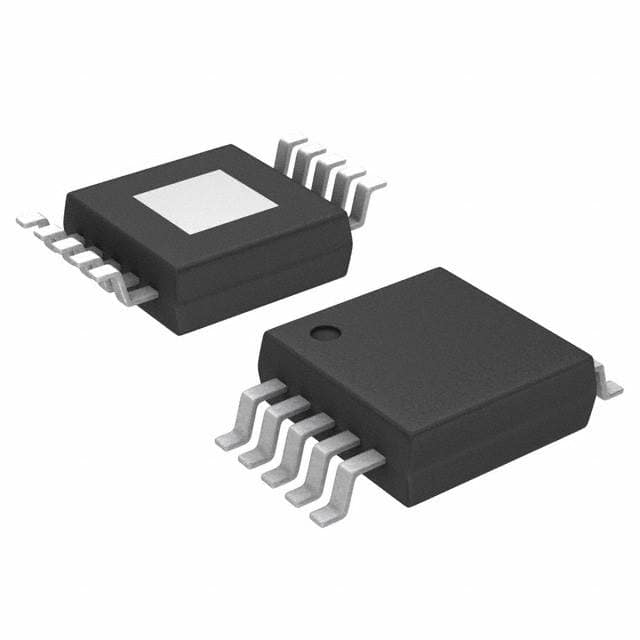BQ24092DGQR
Product Overview
Category
BQ24092DGQR belongs to the category of integrated circuits (ICs) specifically designed for battery charging applications.
Use
This product is primarily used for charging single-cell lithium-ion or lithium-polymer batteries in portable electronic devices such as smartphones, tablets, and wearable devices.
Characteristics
- Input voltage range: 4.35V to 6.45V
- Output voltage range: 3.5V to 4.44V
- Charging current up to 1.5A
- Integrated power FETs for efficient charging
- Thermal regulation and protection features
- Small form factor package for space-constrained designs
Package
BQ24092DGQR is available in a small 10-pin VSSOP (Very Small Outline Package) with exposed thermal pad for enhanced heat dissipation.
Essence
The essence of BQ24092DGQR lies in its ability to provide a compact and efficient solution for charging lithium-ion or lithium-polymer batteries in portable electronic devices.
Packaging/Quantity
This product is typically supplied in tape and reel packaging, with 2500 units per reel.
Specifications
- Input Voltage Range: 4.35V to 6.45V
- Output Voltage Range: 3.5V to 4.44V
- Charging Current: Up to 1.5A
- Operating Temperature Range: -40°C to +85°C
- Battery Regulation Accuracy: ±0.5%
- Charge Termination Accuracy: ±5%
- Standby Quiescent Current: <100µA
Detailed Pin Configuration
- EN (Enable): Enable pin for controlling the charging process.
- STAT (Status): Provides charging status information.
- PG (Power Good): Indicates the presence of input power.
- TS (Thermal Sense): Connects to an external thermistor for thermal regulation.
- VSS (Ground): Ground reference for the IC.
- BAT (Battery): Connection point for the battery being charged.
- SRN (Sense Resistor Negative): Negative terminal of the sense resistor used for current sensing.
- SRP (Sense Resistor Positive): Positive terminal of the sense resistor used for current sensing.
- VBUS (Input Voltage): Connection point for the input power source.
- SYS (System Output): Provides regulated output voltage for the system.
Functional Features
- Integrated power FETs for efficient charging.
- Thermal regulation to prevent overheating.
- Charge status indication through the STAT pin.
- Power Good (PG) pin for input power detection.
- Enable pin for controlling the charging process.
- Under-voltage lockout and overvoltage protection.
Advantages and Disadvantages
Advantages
- Compact form factor suitable for space-constrained designs.
- Efficient charging with integrated power FETs.
- Thermal regulation prevents overheating.
- Accurate battery regulation and charge termination.
- Wide input and output voltage ranges.
Disadvantages
- Limited charging current compared to some high-power applications.
- Requires an external thermistor for thermal regulation.
Working Principles
BQ24092DGQR utilizes a switching charger architecture to efficiently charge lithium-ion or lithium-polymer batteries. It regulates the charging process by monitoring the battery voltage, current, and temperature. The integrated power FETs ensure efficient power transfer from the input source to the battery. The device also incorporates thermal regulation to prevent excessive heating during charging.
Detailed Application Field Plans
BQ24092DGQR finds extensive application in various portable electronic devices, including: - Smartphones - Tablets - Wearable devices - Portable media players - Bluetooth headsets
Detailed and Complete Alternative Models
- BQ24092DRCR
- BQ24092DGQT
- BQ24092DGNR
- BQ24092DQCR
- BQ24092DQCT
These alternative models offer similar functionality and specifications, providing flexibility in design choices.
In conclusion, BQ24092DGQR is a compact and efficient integrated circuit designed for charging lithium-ion or lithium-polymer batteries in portable electronic devices. With its integrated power FETs, thermal regulation, and accurate battery regulation, it offers reliable charging performance. While it has limitations in terms of charging current and the need for an external thermistor, it remains a popular choice for various applications in the portable electronics industry.
Senaraikan 10 soalan dan jawapan biasa yang berkaitan dengan aplikasi BQ24092DGQR dalam penyelesaian teknikal
Sure! Here are 10 common questions and answers related to the application of BQ24092DGQR:
Question: What is the BQ24092DGQR?
Answer: The BQ24092DGQR is a highly integrated single-cell Li-Ion battery charger IC designed for portable applications.Question: What is the input voltage range supported by the BQ24092DGQR?
Answer: The BQ24092DGQR supports an input voltage range of 4.35V to 6.5V.Question: What is the maximum charging current provided by the BQ24092DGQR?
Answer: The BQ24092DGQR can provide a maximum charging current of 1.5A.Question: Can the BQ24092DGQR charge multiple cells in series?
Answer: No, the BQ24092DGQR is designed to charge a single-cell Li-Ion battery only.Question: Does the BQ24092DGQR have overvoltage protection?
Answer: Yes, the BQ24092DGQR has built-in overvoltage protection to prevent damage to the battery.Question: Is the BQ24092DGQR compatible with USB power sources?
Answer: Yes, the BQ24092DGQR is designed to work with USB power sources.Question: Can the BQ24092DGQR operate while charging the battery?
Answer: Yes, the BQ24092DGQR supports simultaneous charging and system operation.Question: Does the BQ24092DGQR have thermal regulation?
Answer: Yes, the BQ24092DGQR has built-in thermal regulation to prevent overheating.Question: What is the typical efficiency of the BQ24092DGQR?
Answer: The typical efficiency of the BQ24092DGQR is around 90%.Question: Can the BQ24092DGQR be used in low-power applications?
Answer: Yes, the BQ24092DGQR has a low-power mode that reduces the quiescent current to maximize battery life.
Please note that these answers are general and may vary depending on the specific implementation and application requirements. It's always recommended to refer to the datasheet and consult with the manufacturer for detailed information.


